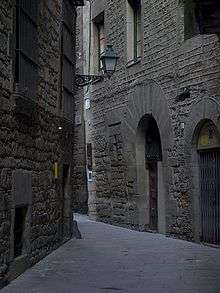Ancient synagogue (Barcelona)
| Ancient Synagogue of Barcelona | |
|---|---|
 Carrer Marlet, in the old Jewish quarter of Barcelona. The Sinagoga Major is on the left. | |
| Basic information | |
| Location | Barcelona, Catalonia, Spain |
| Geographic coordinates | 41°22′57″N 2°10′33″E / 41.38250°N 2.17583°E |
| Affiliation | Judaism |
| Rite | Sephardi |
| Status | Active/Museum |
| Leadership | Josep Prats Cortés |
| Website | http://www.calldebarcelona.org/ |
| Architectural description | |
| Architectural type | Synagogue |
| Completed | 3rd or 4th century |
The Ancient Synagogue of Barcelona (Catalan: Sinagoga Major de Barcelona, Spanish: Sinagoga Mayor de Barcelona, Hebrew: בית הכנסת העתיק מאיור) is believed to be an ancient synagogue located in the centre of Barcelona, Catalonia, Spain. It has been described as one of the oldest synagogues in Europe.[1][2] After many centuries of use for other purposes, the building re-opened as a synagogue and museum in 2002. No congregation prays regularly at the Sinagoga Major, but it is used for festive occasions.[3][4]
History
Archaeological investigations show that the original structure of the building was built in the third or fourth century; whether this structure was the synagogue cannot be said with certainty. The building was significantly expanded during the 13th century.[5] Medieval Barcelona is known to have had several synagogues, and the main synagogue was certainly in the immediate area.[6][7] King James I visited the synagogue in 1263 at the conclusion of the Barcelona Disputation.[8] Shlomo ben Aderet served as the rabbi of the Sinagoga Major for 50 years.[9]
The Jews of Barcelona were massacred in 1391. The building was used for many purposes and its original use was forgotten. Over the centuries, additional stories were added to the building.[10]
In 1987, Jaume Riera y Sans began researching the location of the Sinagoga Major. His research was based on a reconstruction of the route followed by a thirteenth-century tax collector that ended at the Sinagoga Major.[3]
Riera's work led Miguel Iaffa to examine the exterior of the building. Iaffa noted that the structure had been built in compliance with religious requirements that the building should face Jerusalem and that it should have two windows.[3] In fact, the eastward orientation of the building (toward Jerusalem) broke with the northwest/southeast alignment of the streets in its neighborhood.[11]
Iaffa purchased the building in 1995 when its owner put it up for sale. The Call Association of Barcelona (Catalan: Associació Call de Barcelona),[12] led by Iaffa, undertook the recovery and restoration of the synagogue.[4][13] The Sinagoga Major was opened to the public in 2002, and it drew 20,000 visitors during 2005.[4]
In 2003, two Canadians became the first couple to be married at the Sinagoga Major in more than 600 years.[14] A New York attorney donated a 500-year-old sefer Torah (Torah scroll) to the synagogue in 2006.[4]
In January 2009, a right-wing extremist affiliated with the Republican Social Movement attacked the Sinagoga Major.[15][16] He struck the building's facade repeatedly with a baseball bat, and when a synagogue employee approached him, he beat the worker so severely with the bat the man had to be hospitalized with cerebral contusions and a broken arm.[15][17] The attacker was detained by police.[15][16]
See also
Gallery
-

Entrance to the Associació Call de Barcelona (the synagogue)
-
A menorah seen inside the synagogue
-
The sefer Torah (Torah scroll) seen inside the synagogue
References
- ↑ Leviant, Curt; Leviant, Erika Pfeifer (September 18, 2008). "Beautiful Barcelona and its Jews of today and long ago". New Jersey Jewish News. Retrieved January 24, 2016.
- ↑ Katz, Marisa S. (September 14, 2006). "The Golden Age returns". The Jerusalem Post. Retrieved January 24, 2016.
- 1 2 3 de la Fuente, Susan (August 6, 2008). "Catalonian Connection". The Jewish Press.
- 1 2 3 4 "After centuries hidden in rubble, Catalan's Jewish history revived". j. April 14, 2006. Retrieved January 24, 2016.
- ↑ "Medieval Era". Associació Call de Barcelona. Retrieved January 24, 2016.
- ↑ "Conclusions". Associació Call de Barcelona. Retrieved January 24, 2016.
- ↑ Other sources say fifth or sixth century.
Fifth century: "The Jewish Virtual History Tour: Barcelona". Jewish Virtual Library. Retrieved January 24, 2016.
Sixth century: Leviant, Curt; Leviant, Erika Pfeifer (September 18, 2008). "Beautiful Barcelona and its Jews of today and long ago". New Jersey Jewish News. Retrieved January 24, 2016. - ↑ Avneri, Zvi; Beinart, Haim; Assis, Yom Tov (2007). "Barcelona". In Skolnik, Fred. Encyclopaedia Judaica. 3 (2nd ed.). Farmington Hills, Mich.: Thomson Gale. p. 143. ISBN 978-0-02-865931-2.
- ↑ Furmansky, Dyana Z. (March 2006). "The Jewish Traveler: Barcelona". Hadassah Magazine. Hadassah. Retrieved January 24, 2016.
- ↑ "The Jewish Virtual History Tour: Barcelona". Jewish Virtual Library. Retrieved January 24, 2016.
- ↑ "Introduction". Associació Call de Barcelona. Retrieved January 24, 2016.
- ↑ The Catalan word call refers to the Jewish quarter of a city.
- ↑ "About Us". Associació Call de Barcelona. Retrieved January 24, 2016.
- ↑ Arnold, Janice (September 4, 2003). "Montreal couple have first wedding in six centuries in Barcelona shul". Canadian Jewish News. Retrieved January 24, 2016.
- 1 2 3 "Segon atac a una sinagoga de Barcelona en menys d'un mes" (in Catalan). Agencia Europa Press. January 30, 2009. Retrieved January 25, 2016.
- 1 2 "International Religious Freedom Report 2009". Bureau of Democracy, Human Rights, and Labor, United States Department of State. October 26, 2009. Section III. Status of Societal Respect for Religious Freedom. Retrieved January 25, 2016.
- ↑ "Polluting the Public Square: Anti-Semitic Discourse in Spain". Anti-Defamation League. September 21, 2009. Anti-Semitic Incidents in 2009. Retrieved January 25, 2016.
Further reading
- Lazar, Marilyn (December 29, 2015). "Barcelona home to one of Europe's oldest shuls". Canadian Jewish News.
- Makaroff, Sergio (September 30, 2003). "La sinagoga mayor de Barcelona". El País (in Spanish).
External links
| Wikimedia Commons has media related to Ancient Synagogue of Barcelona. |
Coordinates: 41°22′57″N 2°10′33″E / 41.38250°N 2.17583°E